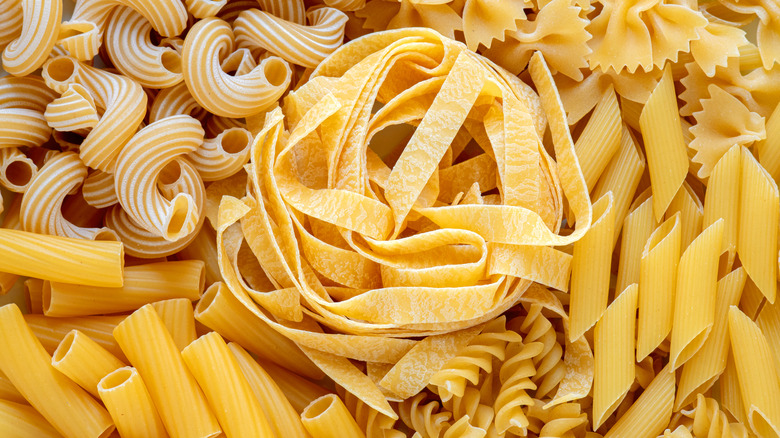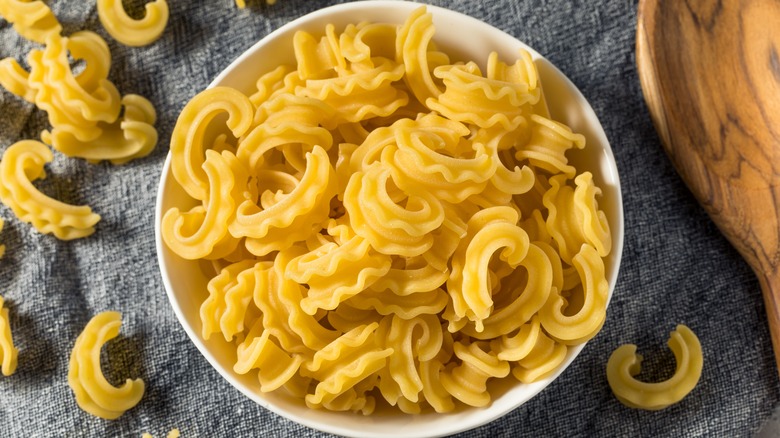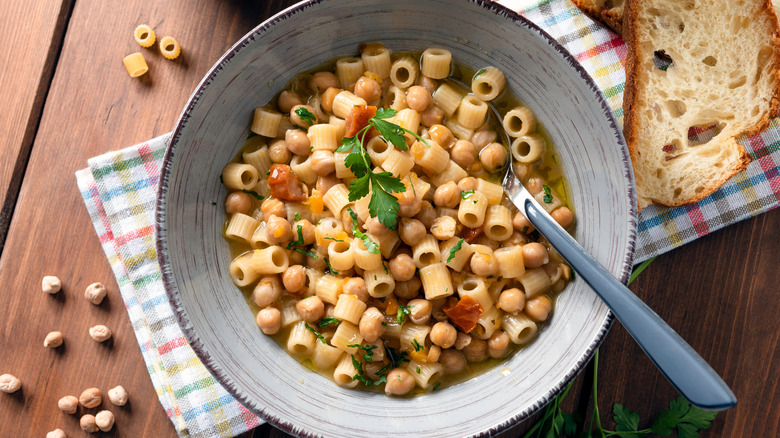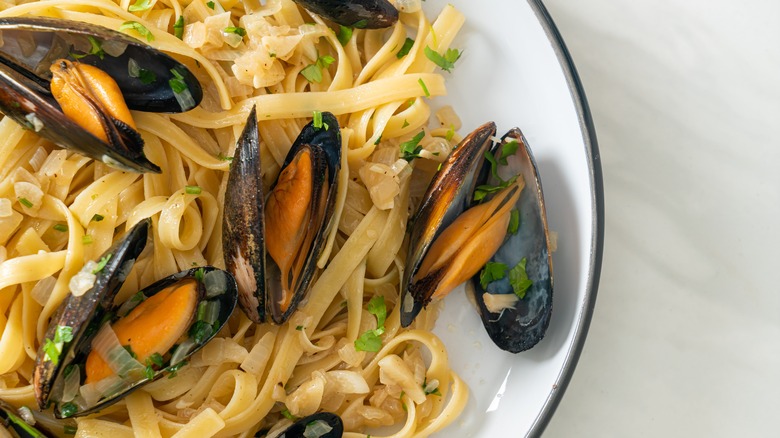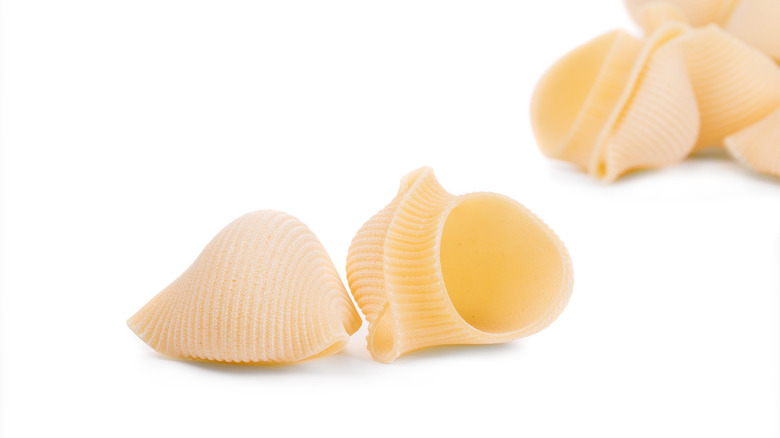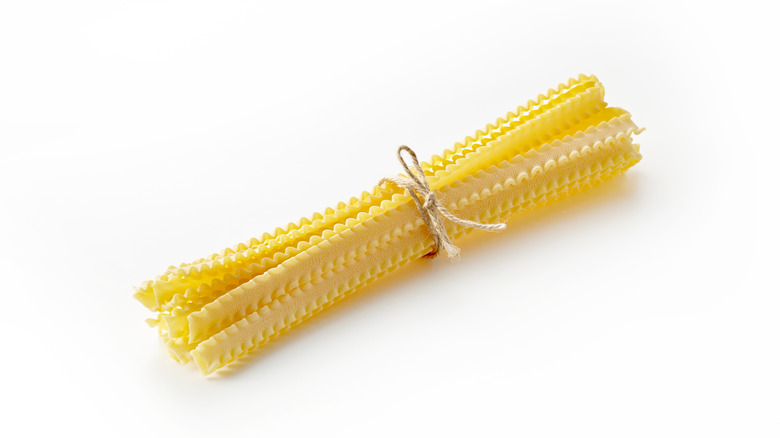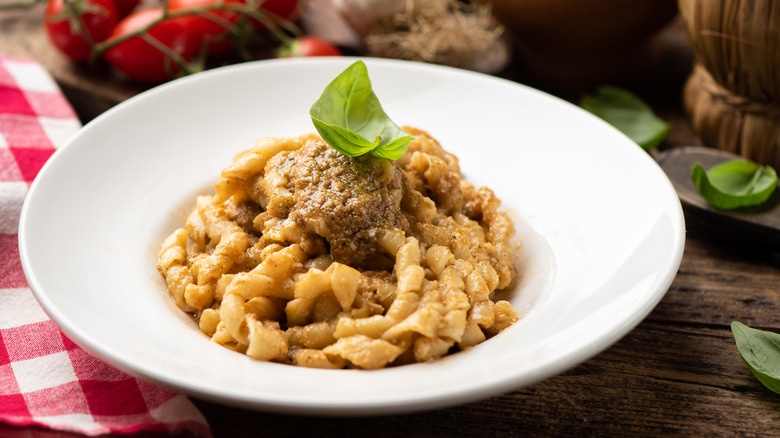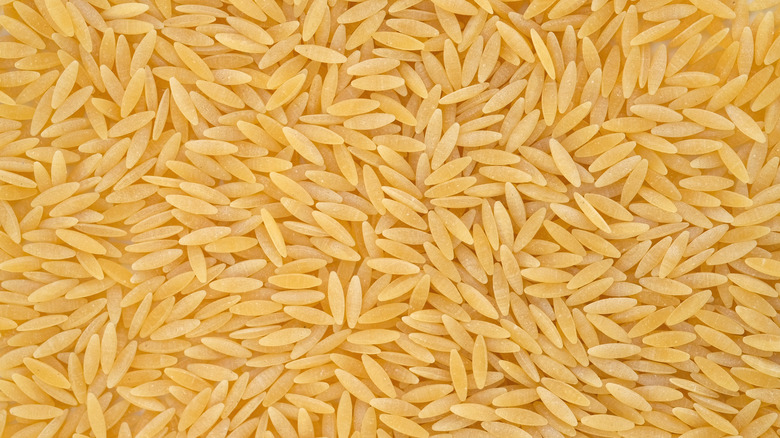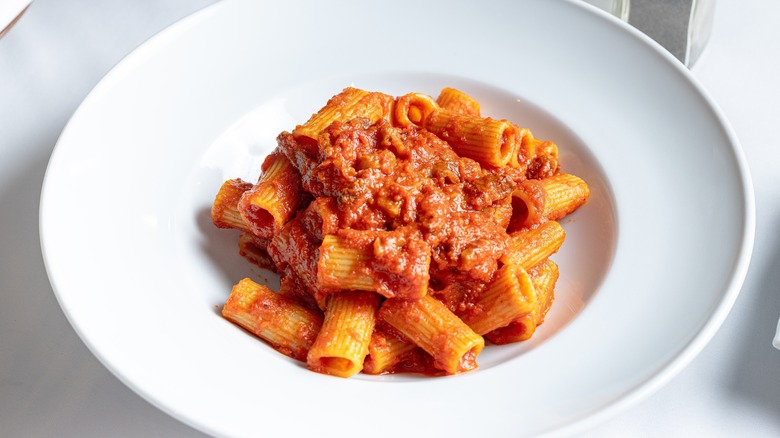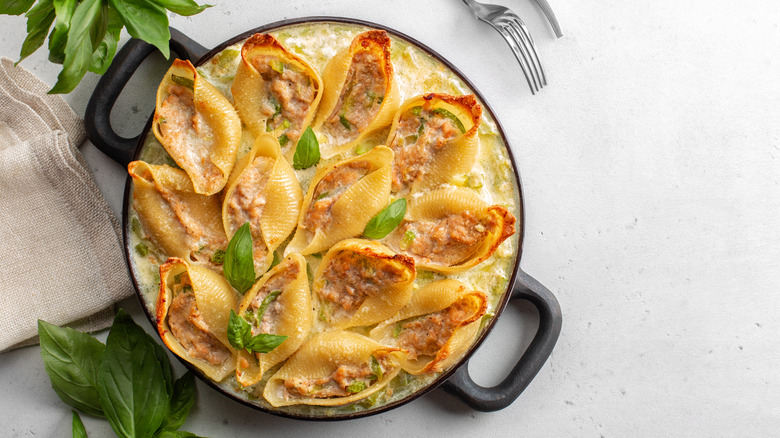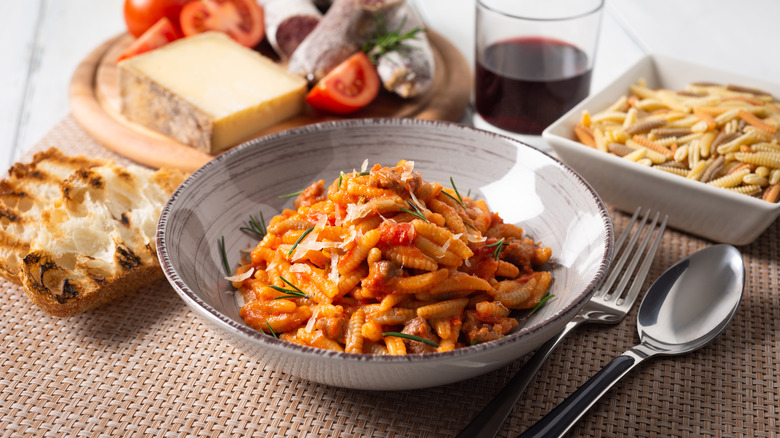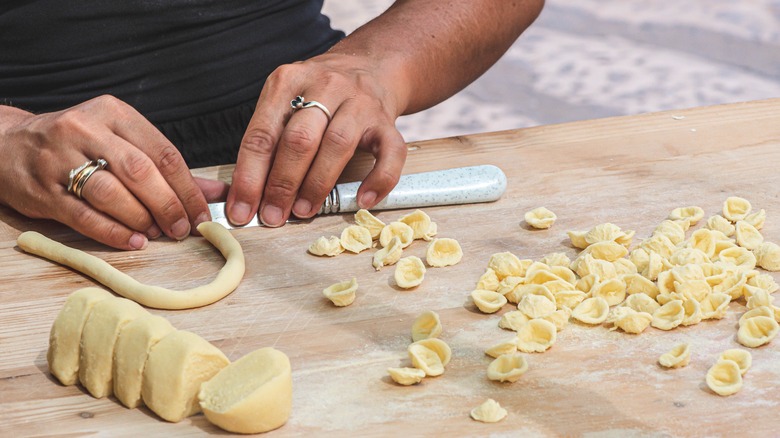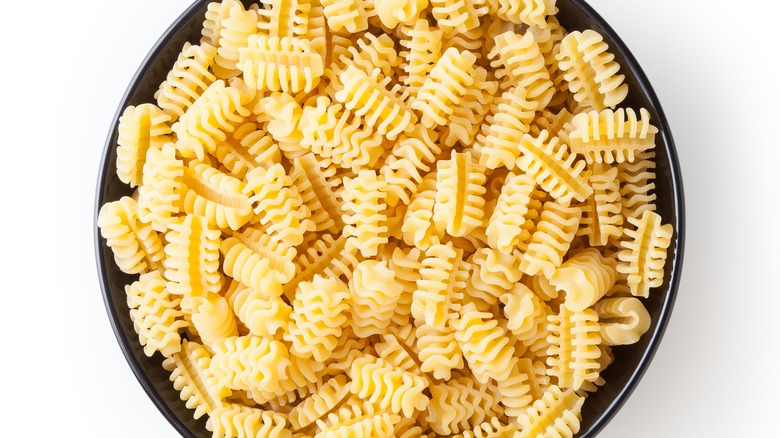12 Unique Pasta Shapes You Need To Start Experimenting With
We may receive a commission on purchases made from links.
Pasta is a stalwart staple in many modern kitchens. According to Statista, 55% of Americans say they eat pasta regularly. This ranges from fresh pasta eaten in restaurants to store-bought pasta cooked at home. Over the years, pasta has become so ingrained in American culture that it features in several of the country's signature dishes, such as spaghetti and meatballs.
Although it was invented in Asia, the cultural home of pasta is Italy. Here, there are some general rules when it comes to using different varieties. For example, ridged pastas are generally paired with sauces that contain chunks of meat or vegetables, whereas small types of pasta typically feature in soups. Interestingly, Italian American dishes often disregard these traditional guidelines, opting instead to use only a few types of pasta — like spaghetti, fettuccine, and penne — to meet all their culinary needs.
There are around 350 types of pasta in the world. So it seems foolish that Americans often resort to the same old pasta type, especially when there are others better suited to the task. Try experimenting with some lesser-known pasta shapes, and you will quickly see how incorporating a variety of pasta will vastly improve your cooking.
1. Cascatelli
Cascatelli was designed by Dan Pashman, host of the award-winning culinary podcast "The Sporkful." During the designing process, Pashman had three qualities in mind: The ease with which a fork could pick the pasta up, how much sauce the pasta could hold, and how satisfying the pasta was to chew. After months of research, he eventually collaborated with the American pasta company Sfoglini. Pashman explained the resulting pasta to Salon: "I would describe the shape overall as a curved comma or half a heart. On one side there's ruffles, and in the space between you've got a dugout, kind of a half-tube that just traps sauce in there. It's amazing."
The unique shape of cascatelli makes the pasta extremely well suited to thick, ragu-like sauces as a great deal of sauce adheres to it. What's more, the presence of right angles means the pasta retains its bite no matter the angle at which it enters the consumer's mouth. Since launching in 2021, Cascatelli has had a massive impact on the culinary world. Time Magazine even named it one of the year's best inventions. As such, cascatelli is a fun and exciting pasta variety to experiment with, and one that will elevate any sauce you throw its way.
2. Ditalini
Americans often overlook smaller pasta shapes in favor of longer noodles or cylindrical alternatives like penne. Yet, in Italy, small pasta types are widely used. Generally, these feature in rustic soups, lending extra body to the dish. The most famous of these is minestrone, although other pasta-rich soups include pasta e fagioli. Both of these dishes form part of Italy's cucina povera, the backbone of the nation's cuisine.
Ditalini are small tubular pieces of pasta. This pasta's diminutive size makes it perfect for inclusion in the hearty soups of cucina povera. As such, they are a common sight in both minestrone and pasta e fagioli. The pasta is also widely used in other recipes across Sicily.
Often featuring legumes, the rustic soups of cucina povera are incredibly healthy as well as filling. Nutritionist Valentina Schirò highlighted this when speaking to La Cucina Italiana: "Often overlooked in the daily menu, [minestrone is] making a comeback because it lets you fill up with a variety of vitamins, minerals, enzymes, antioxidants, and other nutrients that help you stay young and healthy, strong and full of energy."
Not only are these pasta-laden soups healthy — they are also cheap to create. This makes them a brilliant option for all Americans to experiment with. Just be sure to chuck in a handful of ditalini to create the ultimate, authentic experience.
3. Linguine
The first noodle on our list is linguine. This noodle is flatter and slightly wider than the famous spaghetti and it is best known for being served with seafood. Linguine is closely associated with seafood because the pasta was invented in Liguria, a coastal region in northwestern Italy where seafood abounds.
Tony and Cathy Mantuano, a chef and hospitality expert respectively, explained to Time Out why linguine is a great pasta choice to pair with seafood: "Unlike spaghetti, linguine's flat shape offers a larger base to absorb the rich yet light garlic and wine sauce — allowing for the ultimate marriage of pasta and clams. Linguine can hold up to other seafood sauces while also pairing impeccably with delicate sauces, such as aglio, olio e prezzemolo. Not to mention, linguine absolutely upstages spaghetti when it comes to pomodoro or marinara."
For those who do not eat seafood, linguine also has a long history of being served with pesto, potatoes, and green beans. Linguine's versatility makes it a fantastic choice for Americans to cook with.
4. Lumache
Lumache is a well-loved pasta named for the snail shell it resembles. Chef and food writer Allison Arevalo described the pasta shape to Thrillist: "It usually has ridges, and a big hole in the center. I love it because it holds so much sauce! You can make mac and cheese with it, a pork ragu, even vodka sauce. It's so versatile, and a nice change from the staples like spaghetti and penne. Because it's a pretty large shape, every bite is so satisfying."
Lumache's shape also makes it a fantastic choice for pasta dishes that contain pieces of meat or vegetables. These will regularly get trapped inside the pasta, resulting in a flavorful surprise for the diner. What's more, the double opening also makes lumache suited to serving with looser sauces as this too will nestle inside the curved pasta. This extreme versatility marks lumache as a pasta variety all home cooks should have in the cupboard.
5. Mafalde
Mafalde is instantly recognizable thanks to the wavy edges which line both sides of the pasta. Aside from providing an aesthetic appeal, these waves give mafalde its key characteristics: An ability to grip a large amount of sauce and a varied texture. These are two features that make mafalde instantly appealing to consumers. However, the pasta has not achieved the popularity of other long noodles like spaghetti, which is a shame. Arguably, mafalde is better suited to many of the sauces spaghetti is regularly served with, such as bolognese.
Mafalde is also prized for its versatility, as chef Benjamin Dodaro explains to Thrillist. "Mafalde is an extremely versatile pasta, which is why it's one of the best to have in your pantry," he says. "I personally like to describe it as if a wavy lasagna and fettuccine had a baby, they would make mafalde. We make a homemade mafalde verde with sweet Italian sausage, fennel, onions, white wine, Calabrian chili, and finished off with extra virgin olive oil and pecorino romano. This dish is always a guest favorite when it's on the menu."
6. Busiate
The global appeal of pesto is unquestionable — it's the world's second most popular pasta sauce. Usually, pesto is made using pine nuts and served with popular pasta varieties like fusilli. However, there are many variations on the sauce. In Western Sicily, one such variation favors tomatoes, almonds, and basil. Here, this alternative pesto is served with a local type of pasta called busiate.
Busiate is made by twisting pasta dough around a pin. This creates tightly coiled, small pieces of pasta that grip thick sauces — like pesto — exceptionally well. Thanks to its simplicity, busiate is a great pasta to make at home. The dough only requires three ingredients: Semolina flour, water, and salt. Knitting needles or chopsticks can be used as a pin for shaping. Whether you decide to make it fresh or purchase it ready-made, cooking with busiate is a fantastic way to refresh your pesto pasta dish. Who knows, you might even be inspired to recreate the Sicilian pesto mentioned above.
7. Orzo
Due to its size and grain-like shape, orzo is frequently associated with rice. Despite its appearance, however, orzo is a pasta just like any other on this list and should be treated as such. Failure to do so will see the quality of your final dish compromised.
While being significantly different from rice, orzo can be used to make similar dishes, including variations on risotto. Similarly to ditalini, the small size of orzo also makes it well suited to adding body to soups. It's also frequently added to salads. This marks orzo as one of the most versatile pasta varieties in the world.
When cooking with orzo, the one thing to be wary of is the pasta's ability to absorb liquid and consequently expand. If unaccounted for, these characteristics can easily ruin soups. As Chef Claudia Sidoti tells Eat This, Not That, "orzo really expands when you cook it. If adding to soup, I like cooking it separately and then stirring in at the end just before serving, that way you prevent it from absorbing all the broth."
8. Rigatoni
Some of the most popular pasta shapes are tubes such as penne. Rigatoni is a similar shape, although it's wider, shorter, and with a rougher, ridged surface. These ridges are what make rigatoni an excellent option, as they allow vast amounts of sauce to grip onto the pasta. Consequently, this pasta is most often served alongside thick, flavorful sauces.
One such sauce is amatriciana. Originating in Lazio, this spicy red sauce gets an incredible flavor from crisp pieces of pork, often in the form of guanciale. Combining this sauce with rigatoni is a match made in heaven, as chef Fernando Scarpati tells Thrillist: "Rigatoni all'amatriciana is a classic Roman dish, simple but delicious, which has guanciale, pecorino, and tomato. Rigatoni cooked al dente is the only way to eat it. Rigatoni is the best pasta to hold dense sauces because of its ridges, which is why it also goes incredibly well with bolognese sauce or pomodoro sauce."
9. Conchiglioni
Shaped like a shell, conchiglioni offer a way of creating stuffed pasta dishes without resorting to time-intensive classics such as ravioli. So popular is this cooking technique that several of the world's most prominent chefs utilize it, including Arnaud Lallement, who works at the three Michelin-starred L'Assiette Champenoise.
Another feature that makes conchiglioni an attractive choice is its ability to be baked in the oven. This gives cooks access to a uniquely crisp texture, not commonly associated with stuffed pasta dishes. Popular recipes usually include a filling of ricotta and spinach. Larger variations of the pasta are most commonly used for this style of recipe. Smaller varieties, known as conchigliette, are often used in soups.
It is advisable to only buy conchiglioni that is made from hard wheat, such as durum. This will allow the shells to better hold their shape as they undergo first boiling and then baking. Failure to do so may see the conchiglioni become flaccid or mushy, unsavory characteristics in any pasta.
10. Malloreddus
Malloreddus was invented on the island of Sardinia, where it remains an important part of culinary culture. An extremely unique pasta, malloreddus are shaped like small oblong shells, complete with deep ridges on one side. This shape results from the dough being pushed across a lined chopping board. Unsurprisingly, the textured nature of the pasta makes it very adept at gripping sauces.
In Sardinia, malloreddus is most commonly served with a sausage-laden ragu. This dish, known as malloreddus alla Campidanese, is usually flavored with one of Sardinia's premier crops: Saffron. In fact, the flavorful pistils of the plant are sometimes incorporated into the malloreddus dough itself. This is done by dissolving the saffron in liquids that then form the wet part of the simple dough. The result is golden pasta full of intense flavors and aromas. Experiment with malloreddus for incredibly flavorful dishes, the likes of which your guests have never tried before.
11. Orecchiette
Affectionately known as 'little ears', orecchiette are small domes of pasta that originated in Italy's Puglia region. One of the defining characteristics of orecchiette is the varying thickness found across each piece of pasta. The center is significantly thinner than the edges, creating a range of textures when cooked. A rough surface makes the pasta good at gripping sauces. A fact appreciated by cookbook author Rossella Rago, who explains to Thrillist that, "while they're usually paired with sausage and broccoli rabe, I love this ear-shaped pasta with almost anything because the glorious texture on the inside of each one really holds onto sauce like no other pasta does. Tip: Most commercial orecchiette are underwhelming and too smooth. For this cut in particular, opt for bronze extruded pasta or even make your own with a serrated edge knife that will ensure the texture is on point."
What Rago didn't touch on was how the size of orecchiette varies depending on what it is served alongside. Normally they measure just under an inch in diameter. However, orecchiette served with vegetables will often be larger, while those served with ragu are generally smaller. To add flavor to vegetable-heavy dishes, the pasta is commonly boiled alongside the vegetables, infusing the former with flavor. An easy method that could see you elevate any number of pasta dishes.
12. Radiatori
Invented during the 20th century, radiatori are one of the newer pasta varieties. As the name suggests, radiatori are radiator shaped: Small ad condensed with high ridges. This maximizes the surface area of the pasta, meaning more sauce can adhere to each piece. Often, radiatori is used in place of the similarly shaped fusilli. That being said, the unique shape also makes radiatori a great choice for pasta salads. Here, the pasta lends a unique aesthetic that is sure to catch the eye of every diner.
Despite their outlandish appearance, radiatori are relatively easy to find in the United States thanks to Target's Good & Gather brand, which sells bronze cut radiatori nationwide. The product has received overwhelmingly positive reviews with one Target customer even stating that "radiatore pasta is a shape that is hard to find in the regular market so I was so happy that Target carries them ... It's a really fun shape! I used it to make the viral baked goat cheese pasta. It was really tasty. Some things I like about this pasta is that it has two grams of fiber, is made with 100% durum wheat semolina, and also that it is imported from Italy. I would 100% buy this again!"
